Different Bow Types For Yachts
Find out the advantages and disadvantages of each bow type before committing to buying a boat.
April 21, 2025
What are the different types of boat bows?
The boat bow is the leading edge of a yacht and pierces oncoming waves. Ships, sailing yachts, super yachts and powerboats have different constraints and operate differently to suit a range of purposes, from commercial ships, to racing boats to cruising. Find out more about technical considerations associated with bow types. A user's navigational, lifestyle requirements and personal styling are all determining factors to consider when deciding on bow type.
Bow types play an essential role in naval architecture
The varied shapes of yacht bows have style and functional benefits. As the part of the hull that first meets waves when underway, the shape and construction directly impacts the vessel's performance and cruising capability. The angle of entry at the bow directly impacts the boats performance.
On a motor yacht a fine angle of entry, 12 degrees for instance, is suited to high-speed semi-displacement style yachts, whereas a standard yacht will have a half-angle entry which is between 18 to 24 degrees. Here are some of the bow shapes and examples to help you decide which bow shape suits your boat buying needs. On a superyacht, a bow increases the living space inside the hull which tends to be prioritized over its seakeeping capability.
Bulbous bows (below water)
Best for: large vessels operating at high speeds.
Bulbous bows are generally only found on yachts with a displacement. The flare or bulbous bow is a rounded protrusion below the waterline which modifies the way the water flows around the hull, reducing drag and thus increasing speed, range, fuel efficiency, and stability. This type of bow is only used on motor yachts, not sailing yachts.
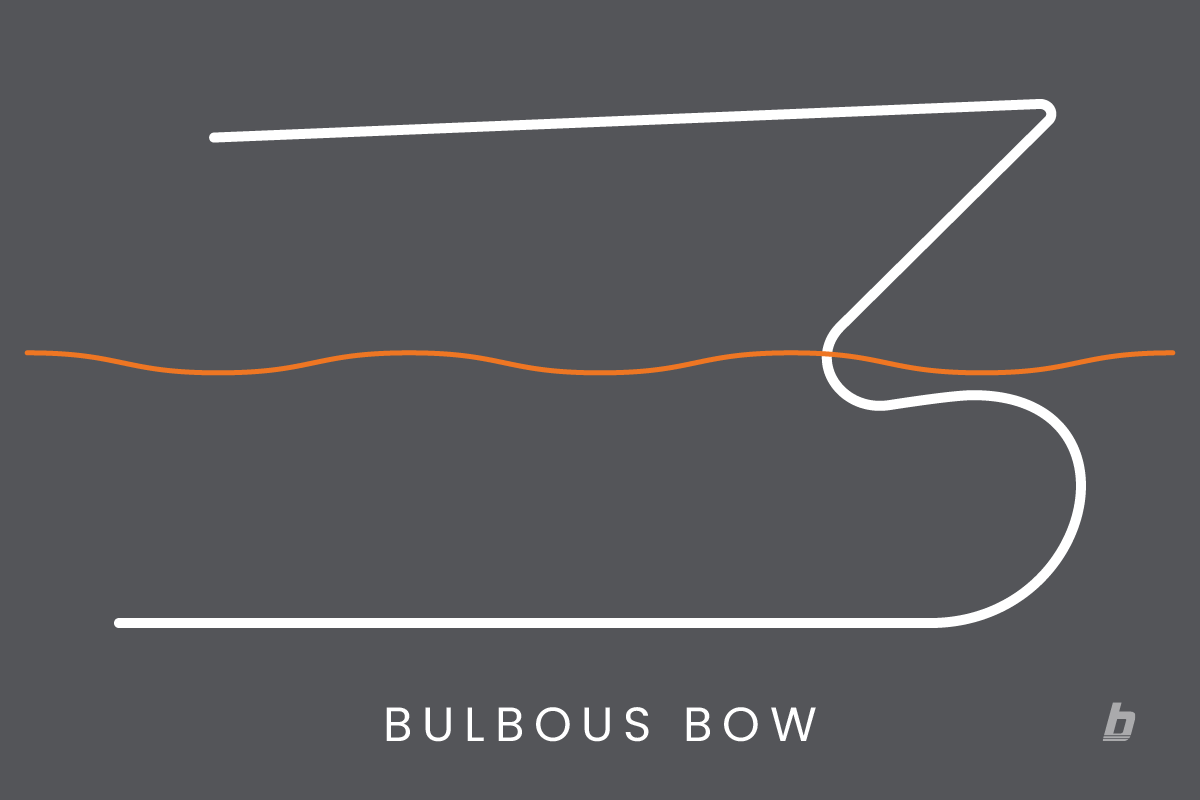
Above: Bulbous bow illustration. Image via boats.com
Flared bow (above water)
Best for: sea handling in rough sea states.
Featuring an outward flare above the waterline, flared bows help to direct spray away from the boat to improve sea handling. They are commonly seen on sportfishing boats and other small to medium-sized motor yachts.
A perfect example of a flawed bow is the ‘Carolina flare’ commonly featured on convertible sportfish yacht designs in brands such as Outer Banks. The concept is that a fine angle of entry drives into the waves, and as a wave size increases, the flare rises up over them, throwing the water back into the ocean without getting the deck wet. This type of bow typically uses a chine or lifting strakes carried well forward to help to push water to one side and provides additional buoyancy as the point of entry crashes into a wave.
The biggest drawback of this type of bow is that as a yacht slams into a wave, the gradual immersion of the flare causes the bow to pitch upward (vertical acceleration), causing the entire yacht to move, slowing it down and therefore requiring more power, using more fuel to drive the yacht.
If the bow submerges into water it can act as a scoop, digging into the water and throwing it across the deck.
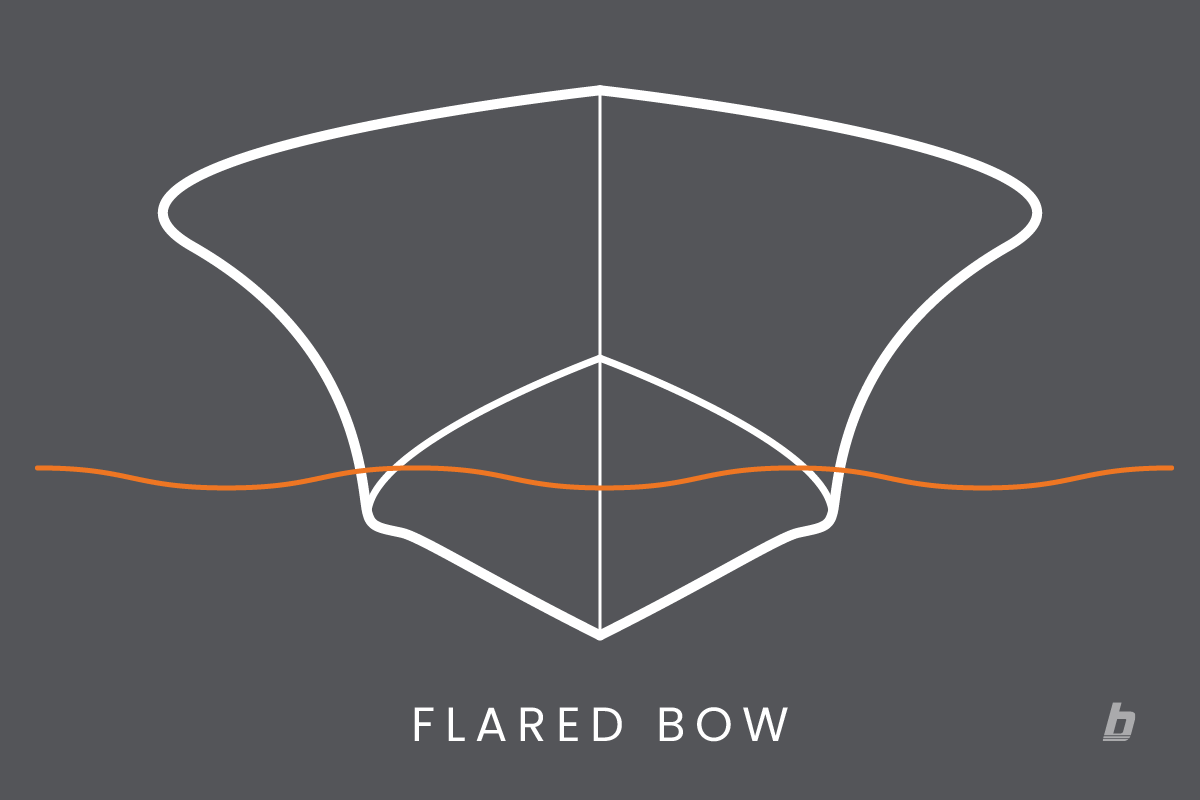
Above: Flared bow type. Image via boats.com
Raked Bow
Best for: stability and maximizing interior space.
A personal favourite for stylistic reasons, the raked bow is often featured on traditional gentleman's sailing yachts. It is characterised by its inverted slope from the waterline to the deck. Commonly found on both motor yachts and sailboats. They are popular for their stability, ability to deflect spray, and the extra interior space they provide.
Functionally, raked bows raise the centre of buoyancy, which in turn increases the metacentric height (GM), one of the key pillars of hull stability. The angle of the rake can make a boat more stable and reduce drag. Feadship Yachts often feature a signature raked bow. Examples include Herculina, Project 1014, Sakura, and Aquarius.
One drawback of a raked bow is increased buoyancy when riding big waves, which can cause pitching and slamming motions and a slower passage through the water.

Above: Raked bow example. Image via boats.com
Plumb bow
Best for: interior volume and fuel efficiency.
Plumb bows are having a resurgence and are popular on cruisers. As its name suggests, a straight or plumb bow is almost perpendicular to the water, resembling a plumb line. Because a plumb bow maximises waterline length, it helps to increase the speed the hull travels through water and therefore reduces fuel consumption. However, turning can be harder work due to the extended waterline. It also augments interior space in the forward part of the hull. With a narrow point of entry, a vertical bow slices through waves rather than ride over them for smooth, fuel-efficient passage-making. Often thought of as a modern design feature.

Above: Plumb bow illustration. Via boats.com
Clipper Bow
Best for: maximizing speed.
Stylistically the clipper conjures up images of a pirate ship, coupled with trailboards and a bowsprit (a spar pole extending forward from the bow of a sailing vessel. Defined by its sharp, pointed, and slender shape, designed to minimize resistance and maximize speed.
The most traditional is the clipper bow, which was first designed back in 1839 in Aberdeen. With this style, the bow inflects inwardly while curving forward. Some examples include Vagabond, Cabo Rico, Bayfield, Formosa.
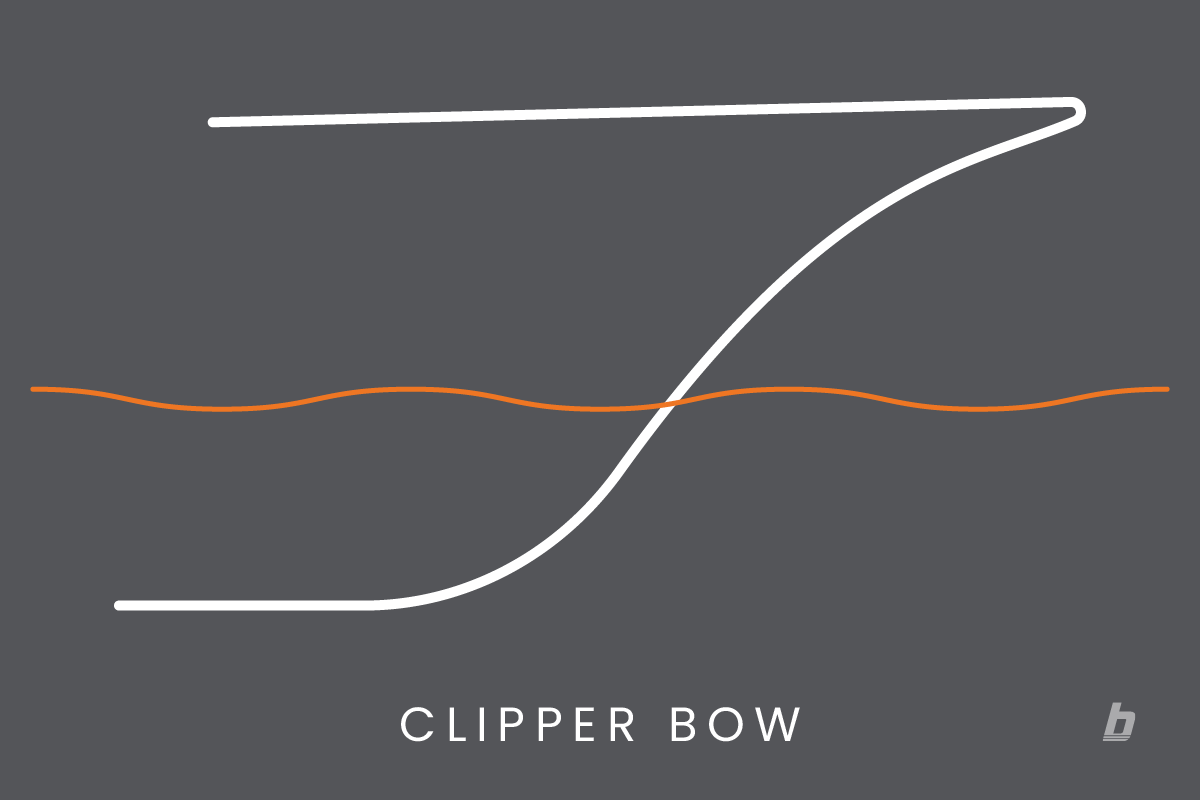
Above: Clipper bow type. Image via Clipper.
Reverse bow (wave-piercer)
Best for: a smoother passage through waves
Also known as an inverted bow or ram bow. Its most forward point at the waterline, which clearly maximizes waterline length which is advantageous for resistance and powering. It also reduces the forward deck area. A reverse bow has wave piercing attributes as it cuts through the water which dissipates over the top of the bow. The drawback is a wetter foredeck and therefore sometimes a pronounced spray rail is necessary.
Feadship’s 72.80-metre Predator launched in 2008 with one of the very first reverse bow yachts of the modern era. The yacht’s distinctive reverse bow profile is the result of the owner’s brief for a high-speed yacht capable of 25 knots.
The first was a traditional hull with a bulbous bow, and the second was a reverse bow. In the end, the owner liked the aggressive styling of the latter, so it was both a technical and an aesthetic decision.

Above: Reverse bows are sometimes referred to as 'hammerhead' or 'X-bows'.. Image via boats.com
Axe bow
Axe bows are found on offshore racing boats and patrol vessels. Characterised by a sharp and vertical bow, it aims to reduce drag and improve a boat's stability in rough sea conditions.
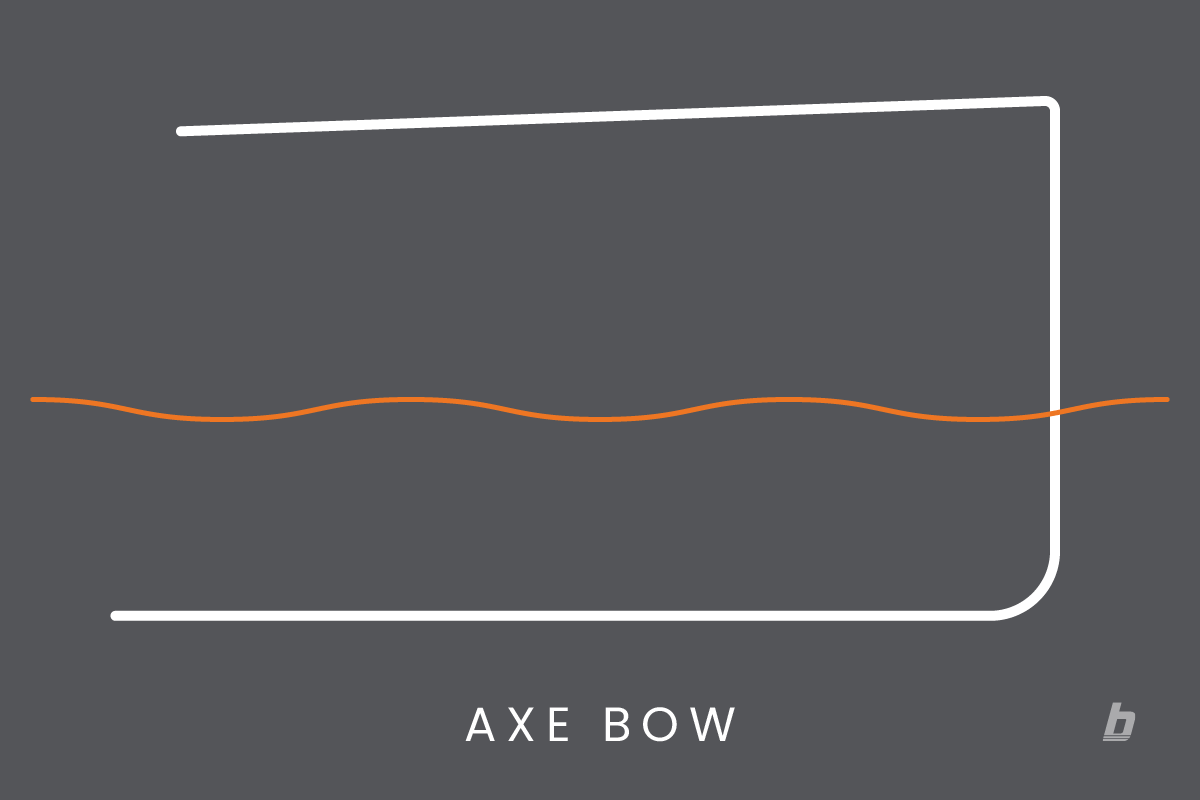
Above: Axe is a wave-piercing bow. Image via boats.com
Spoon bow
Synonymous with classic yachts and predominantly used on sailing yachts, a spoon bow is an overhanging bow of a ship whose underside is somewhat spoon-shaped. Instead of cutting sharply into the water, a spoon bow rises smoothly up from the waterline, creating a more graceful and buoyant entry into waves. The smooth curve helps reduce pounding or slamming in choppy seas. Passengers can enjoy a dry ride as the curved bow tends to push water aside rather than letting it splash up over the deck.
Older motor yachts from the early 1900s often featured spoon bows but they are rarely used in modern motor yachts because they limit the vessel from reaching high speeds.
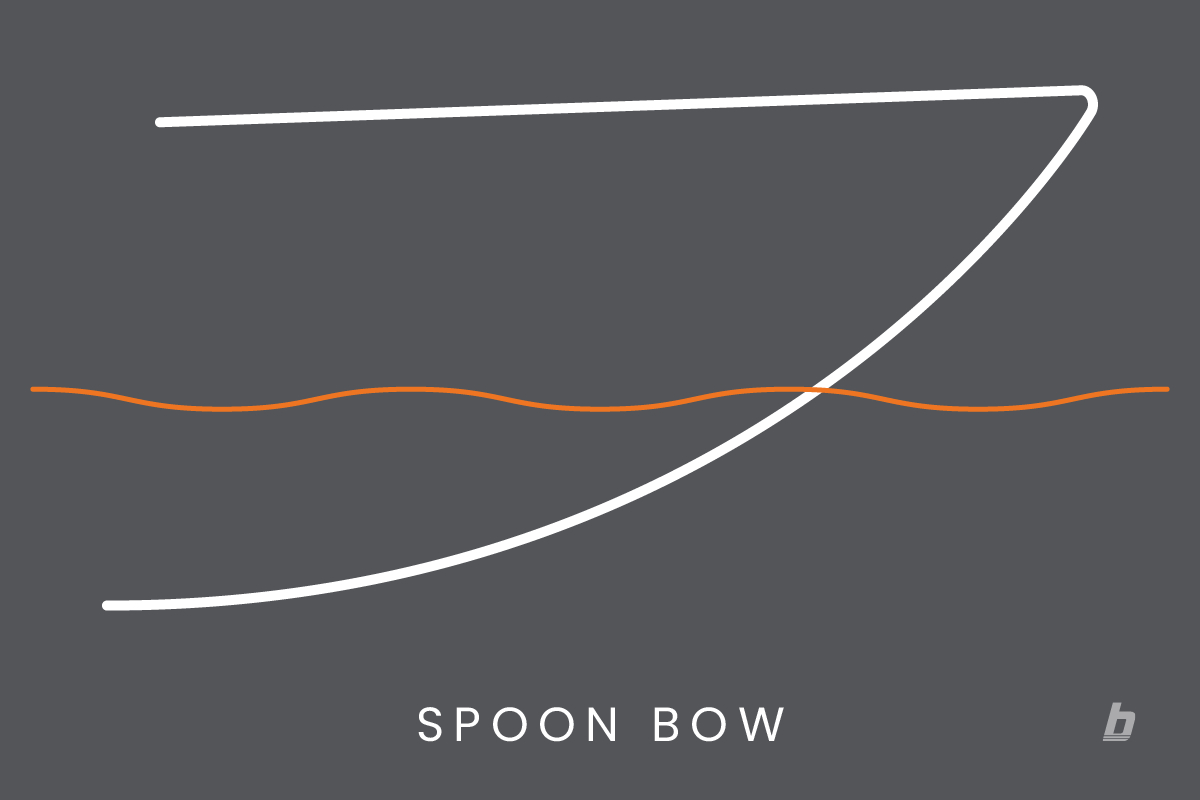
Above: Spoon bow. Image via boats.com
If you want to learn more about the basics of naval design you might be interested in Boat Hull Shape Design Options.
Q&A
What are the most popular yacht bows?
A raked bow, a plumb bow and a reverse bow.
What is the bow of a yacht?
The bow is the forward part of the hull of a ship or boat when underway. The aft end of the boat is the stern. Prow may be used as a synonym for bow or it may mean the forward-most part of the bow above the waterline.












